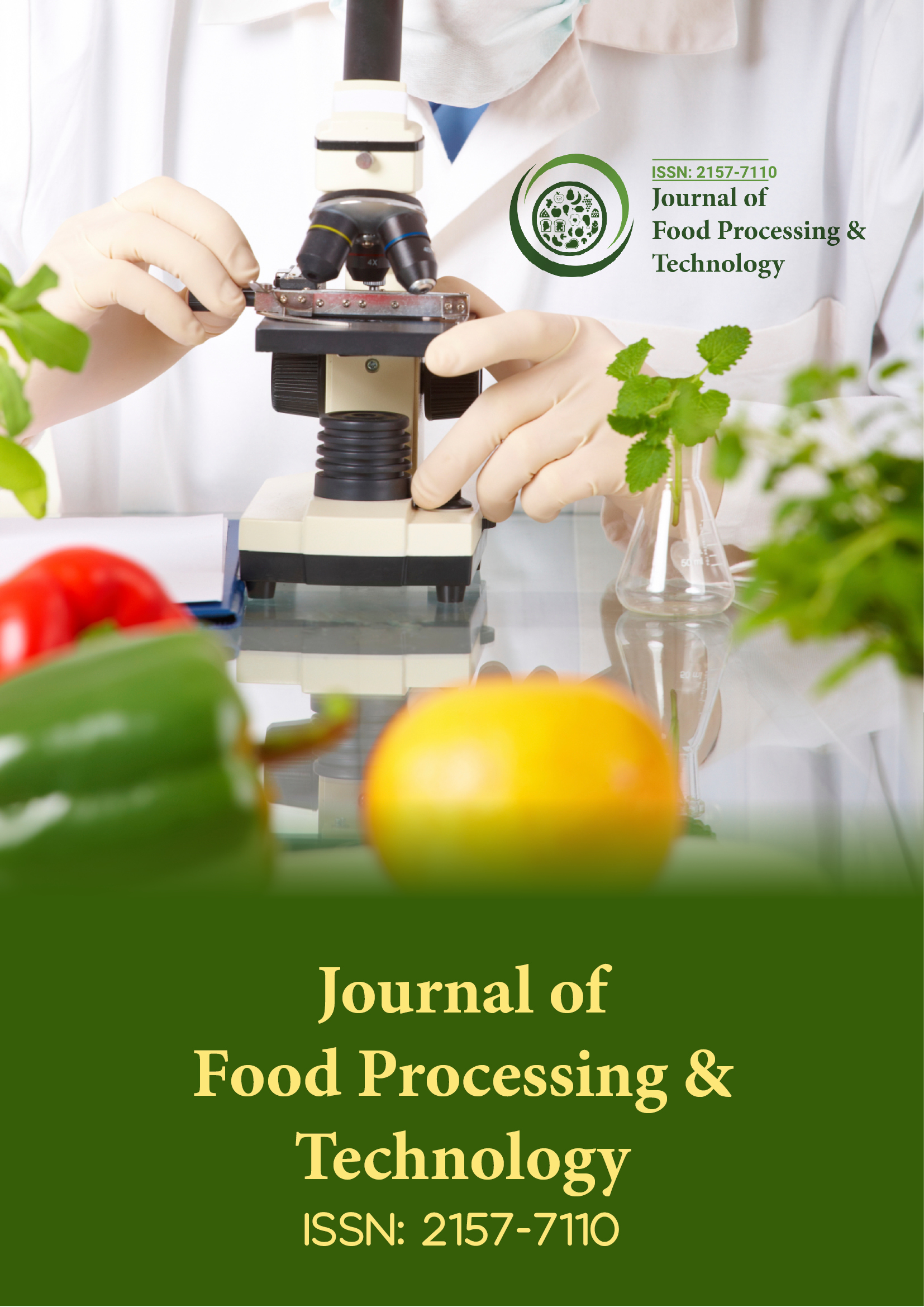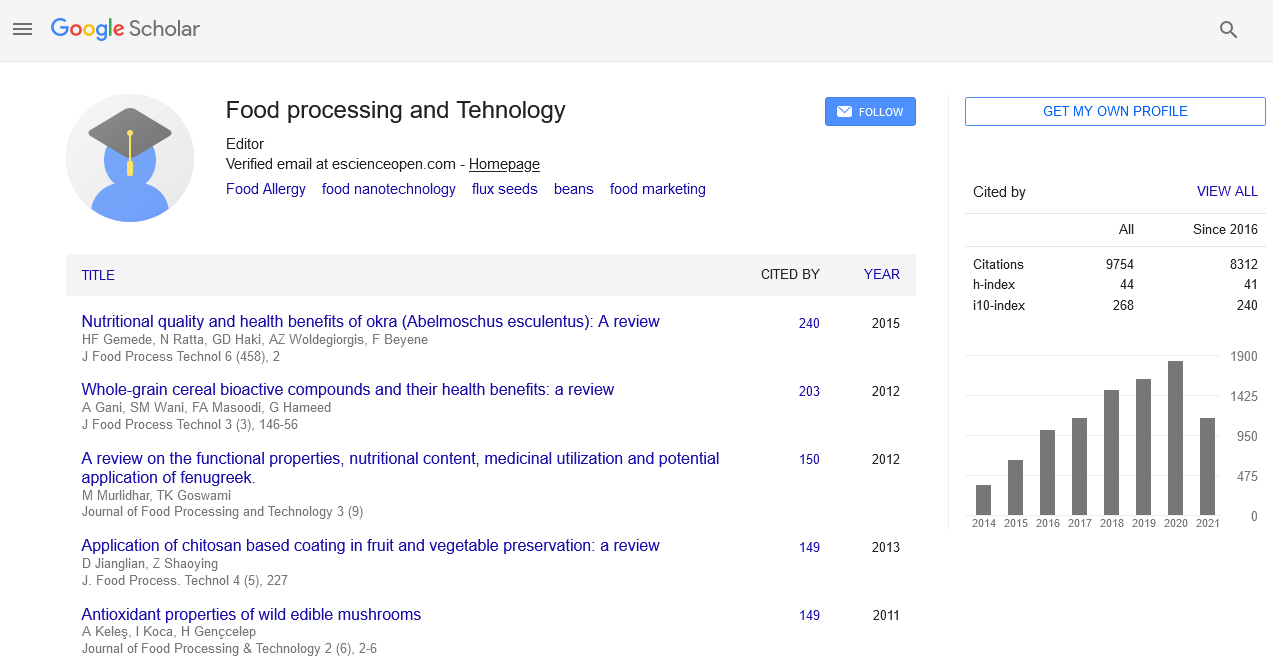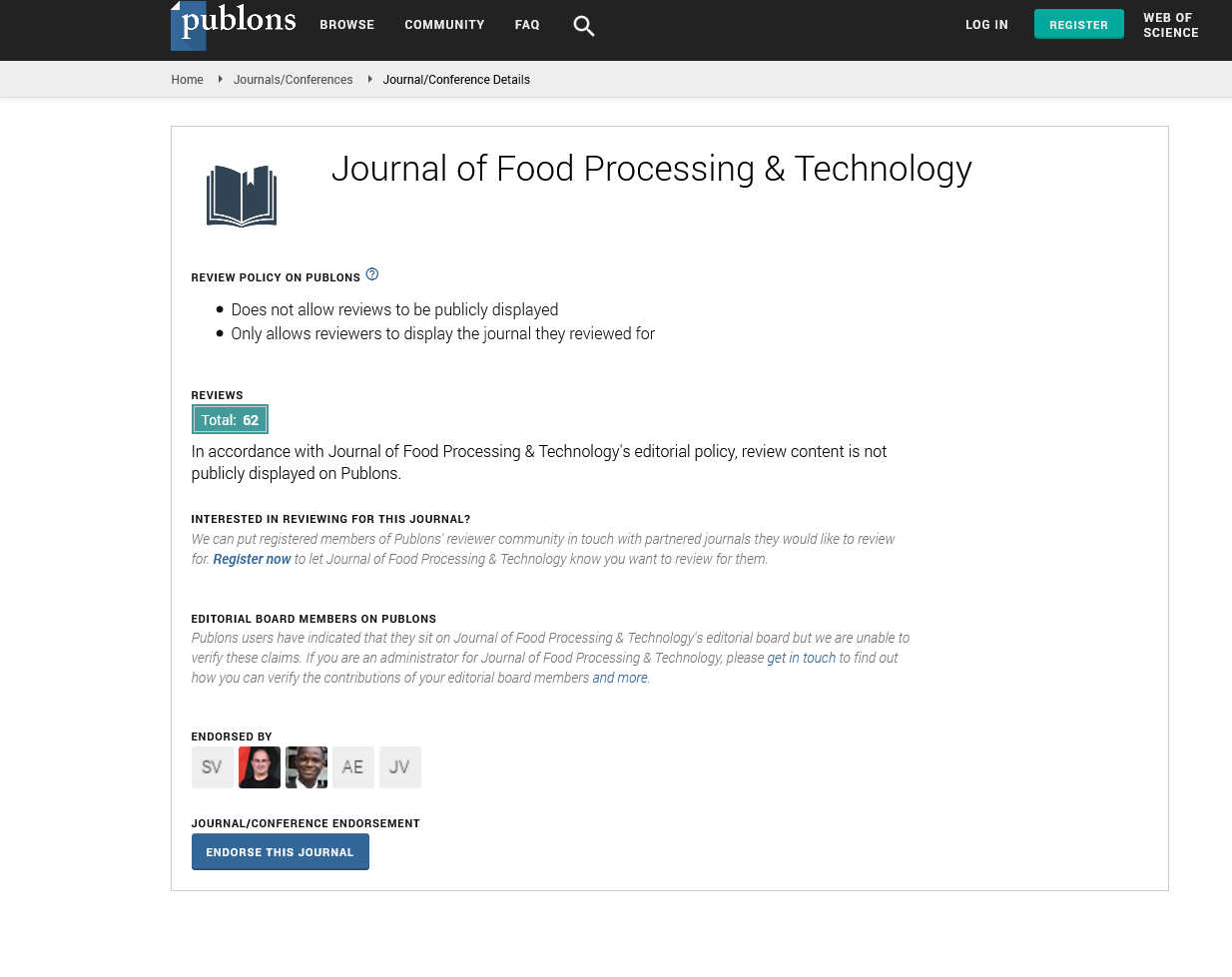Indexed In
- Genamics JournalSeek
- Academic Keys
- JournalTOCs
- China National Knowledge Infrastructure (CNKI)
- Access to Global Online Research in Agriculture (AGORA)
- Centre for Agriculture and Biosciences International (CABI)
- RefSeek
- Directory of Research Journal Indexing (DRJI)
- Hamdard University
- EBSCO A-Z
- OCLC- WorldCat
- Scholarsteer
- SWB online catalog
- Publons
- Euro Pub
- Google Scholar
Useful Links
Share This Page
Journal Flyer

Open Access Journals
- Agri and Aquaculture
- Biochemistry
- Bioinformatics & Systems Biology
- Business & Management
- Chemistry
- Clinical Sciences
- Engineering
- Food & Nutrition
- General Science
- Genetics & Molecular Biology
- Immunology & Microbiology
- Medical Sciences
- Neuroscience & Psychology
- Nursing & Health Care
- Pharmaceutical Sciences
Commentary - (2025) Volume 16, Issue 2
Advances in Packaging Solutions for Extending Shelf Life of Fresh Produce
Maria Fernandes*Received: 28-Mar-2025, Manuscript No. JFPT-25-29635; Editor assigned: 31-Mar-2025, Pre QC No. JFPT-25-29635; Reviewed: 14-Apr-2025, QC No. JFPT-25-29635; Revised: 22-Apr-2025, Manuscript No. JFPT-25-29635; Published: 28-Apr-2025, DOI: 10.35248/2157-7110.25.16.1149
Description
Packaging plays a fundamental role in the preservation and distribution of fresh produce. Fruits and vegetables are highly perishable commodities that undergo rapid physiological and microbial changes once harvested. Traditional packaging methods provided basic protection against physical damage, but modern food distribution demands more sophisticated systems capable of extending shelf life while maintaining quality. Recent research has focused on developing packaging materials and techniques that address these requirements. Modified atmosphere packaging has become one of the most effective strategies for preserving fresh produce. By controlling oxygen, carbon dioxide, and nitrogen levels inside the package, the respiration rate of fruits and vegetables can be slowed significantly. This delays ripening and reduces microbial activity, allowing products to reach distant markets without major quality losses. For example, apples stored under reduced oxygen conditions remain firm and fresh for several months compared to those stored in regular air.
Another innovation is the development of active packaging, where the packaging material itself interacts with the food to enhance preservation. Antimicrobial films containing natural extracts or essential oils are being used to inhibit bacterial growth on produce surfaces. Similarly, moisture-absorbing pads prevent excess humidity, reducing the likelihood of fungal contamination. These approaches provide an added layer of protection beyond conventional packaging. Biodegradable materials have also gained momentum as sustainable alternatives to plastic-based packaging. Polylactic acid and starch-based films are being tested for their ability to protect produce while minimizing environmental impact. Though challenges remain in terms of cost and mechanical strength, these materials align with global efforts to reduce plastic waste and promote eco-friendly practices.
Nanotechnology is contributing to further advances in packaging. Nanocomposites with enhanced barrier properties are being integrated into films to reduce gas permeability and improve mechanical strength. Additionally, nanosensors are being embedded into packaging to provide real-time information about product freshness, enabling consumers and retailers to monitor quality directly. Cold chain management complements packaging innovations by ensuring that temperature conditions are maintained from harvest to consumer. Smart packaging with time–temperature indicators provides visual cues when produce has been exposed to unfavorable conditions, thereby improving transparency in food distribution systems. From an economic perspective, extended shelf life reduces food waste and improves profitability for producers and retailers. Longer storage and transport periods open access to international markets, allowing seasonal produce to be enjoyed year-round in regions where they are not grown locally. This global trade opportunity contributes to food security and consumer satisfaction.
Consumer acceptance is also influenced by packaging choices. Shoppers are increasingly aware of sustainability issues, and products packaged in biodegradable or recyclable materials often gain a competitive edge. Clear labeling about packaging benefits, such as freshness indicators, further enhances consumer trust.
Future research is expected to refine the balance between sustainability, cost, and functionality. The integration of biodegradable films with active and intelligent features could represent the next stage of packaging evolution, combining preservation with environmental responsibility. Packaging innovations are no longer limited to protection alone but now play a dynamic role in extending shelf stability, reducing waste, and enhancing market opportunities for fresh produce. The continued development of these technologies will shape the future of global food distribution systems.
From an economic perspective, innovations in packaging bring substantial benefits. By extending shelf life, they reduce food waste, which is a major challenge globally, particularly for fruits and vegetables. Producers and retailers benefit from longer selling periods and reduced losses during transportation and storage. Moreover, extended shelf life facilitates international trade, enabling seasonal produce to be available year-round in markets where it is not locally grown. For example, grapes from Chile or avocados from Mexico can reach consumers in Europe or Asia in good condition thanks to advanced packaging and cold-chain management. This contributes not only to profitability but also to global food security and consumer satisfaction.
Consumer perception and acceptance are also shaped by packaging choices. Today’s shoppers are increasingly aware of sustainability and food safety issues. Products packaged in biodegradable or recyclable materials often command higher trust and preference. Packaging that clearly communicates its benefits such as freshness indicators, “eco-friendly” labels, or extended shelf life claims further enhances consumer confidence. Transparency in packaging technologies fosters stronger relationships between producers, retailers, and end-users, creating a market environment where innovation is rewarded.
Looking ahead, future research is expected to refine the balance between sustainability, functionality, and cost-effectiveness. One promising direction is the integration of biodegradable films with active and intelligent features. Such systems would combine environmental responsibility with superior preservation, reducing reliance on plastics while ensuring quality and safety. Advances in material science, nanotechnology, and sensor integration are expected to play central roles in shaping this evolution.
Citation: Fernandes M (2025). Advances in Packaging Solutions for Extending Shelf Life of Fresh Produce. J Food Process Technol.16: 1149.
Copyright: © 2025 Fernandes M. This is an open access article distributed under the terms of the Creative Commons Attribution License, which permits unrestricted use, distribution and reproduction in any medium, provided the original author and source are credited.


